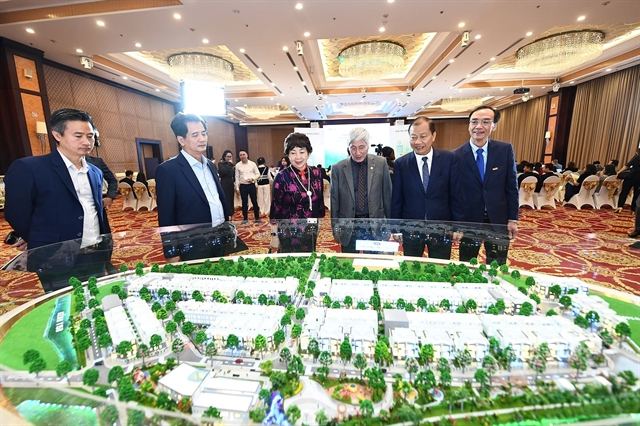As Việt Nam undergoes a significant administrative transformation - reducing its map from 63 to 34 provinces and cities - businesses, particularly in the real estate and manufacturing sectors, are closely monitoring how planning adjustments will unfold.

Việt Nam’s ongoing administrative reforms are expected to remove procedural bottlenecks, enhance transparency and increase the appeal of the real estate sector to both domestic and foreign investors, according to insiders.
These reforms are marked by the rollout of a two-tier local administration model and the merging of multiple administrative units. The initiatives are ushering in significant changes to local governance.
Assessing the impact of the new model, Đỗ Thị Thu Giang, Advisory Services director in HCM City for Savills Vietnam, said that the deeper decentralisation of authority to local administrations would help reduce processing time for construction permits and project approvals, thereby reducing opportunity costs and increasing investment efficiency.
"One of the business community’s major expectations is that the overhaul will be accompanied with significant improvements in transparency and information accessibility," she said, adding consolidating approval authority at the provincial level is seen as an effective way to eliminate overlapping in approval and inconsistent legal interpretations – one of the biggest barriers for foreign investors.
Digital transformation initiatives such as building a national land database system and implementing electronic licensing would contribute to enhanced transparency in land management, Giang said. This would provide the foundation for the real estate market to better align with international standards.
Together with the two-tier local administration model, the merger of localities would also impact land valuation and land finance policies. Under the 2024 Land Law, localities must set new land prices appropriate to each area’s characteristics.
"The law clearly stipulates principles for land price differentiation by specific location, potentially down to individual plots if sufficient data exists, while preventing the application of uniform pricing that lacks accuracy," Giang added.
Experts believe that granting higher autonomy to localities in investment attraction policies is expected to promote healthy competition between regions.
However, this requires investors, particularly international ones, to thoroughly assess the locality's governance capacity, development orientation and regional compatibility with business strategies.
Trần Đình Thiên, PhD, a member of the Government Economic Council, observed the bold and pioneering approaches by several localities like the former provinces of Ninh Thuận and Quảng Bình, saying administrative reforms would be effective only if they are accompanied by strong strategic approaches.
"While the potential is clear, the actual impact of the reforms hinges on the enforcement of policies from the central to local levels. Therefore, continued legal reforms in such areas as land, housing and investment, along with better capacity of officials in operating the new apparatus, are the key to the realty market's development," Thiên said.
Nguyễn Hoài An, senior director and head for CBRE Vietnam in Hà Nội, pointed out that one of the major challenges was legal complications, including determining land prices, calculating land use fees, and land clearance.
The formation of a land use right trading floor would help establish land prices closer to market rates, limiting speculation, price manipulation, and realty bubble, An said.
Post-merger urban planning
As Việt Nam undergoes a significant administrative transformation - reducing its map from 63 to 34 provinces and cities - businesses, particularly in the real estate and manufacturing sectors, are closely monitoring how planning adjustments will unfold. For many, these changes could serve as either a strategic catalyst for growth or a barrier to development.
With mergers between localities reshaping the administrative and economic landscape, planning has become a top concern.

Nguyễn Văn Đính, chairman of the Vietnam Association of Real Estate Brokers (VARS), highlighted key issues for property businesses and individual traders on which cities will emerge as primary hubs, and which will become secondary or take on new functions.
"For instance, there is high interest in areas with robust infrastructure and economic connectivity, such as the greater HCM City region.
“Previously, each was a strong economic pillar. Now, there's concern that after its merger the former Bình Dương Province may lose its competitive edge to HCM City,” Đính said.
Businesses are also closely watching the capacity of local authorities to handle these transitions. The implementation of new policies, efficient administrative handling and continuity in supporting production and investment are all seen as vital.
Lê Xuân Nga, general director of BHS Property, emphasised that consistency in legal and procedural frameworks would be critical.
“We’ve made significant effort to navigate the current system. Stability is essential to avoid wasted resources,” he said.
Regional planning is another point of focus. Developers are concerned about how redrawn boundaries will affect land use, infrastructure and previous development plans. With each locality having its own planning logic, aligning new regional strategies after merger remains a complex challenge.
Investment procedures also need clarity and flexibility. Businesses seek transparent and efficient mechanisms that allow them to fully leverage their resources. However, institutional challenges persist.
According to Đính, despite recent reforms, regulatory inconsistencies - particularly around land pricing - continue to cause concern.
“Sharp increases in land prices not only burden investors but also create instability in transactions, from buying and selling to leasing,” he warned. "Such volatility can raise production costs and undermine competitiveness."

Real estate market outlook
Looking at broader market trends, Trần Quang Trung, business development director at One Mount Group, said that speculative real estate products would stall or flatten in value.
However, in secondary markets like Hà Nội and HCM City, moderate and steady price increases were expected - without sudden spikes, Trung said.
Despite existing hurdles, experts remain optimistic about the Vietnamese real estate market’s outlook in the second half of 2025. The mid-range apartment and affordable housing segments are expected to garner strong investor interest, while the rollout of public projects is anticipated to have a positive ripple effect.
Supportive government policies - ranging from legal streamlining and land price list adjustments to boosted public investment and preferential credit - are starting to yield results, albeit unevenly across segments and regions.
VARS forecasts continued recovery momentum in the residential housing market, fuelled by low interest rates, improving legal clarity and sustained real demand.
However, the ongoing imbalance between supply and demand is unlikely to be resolved soon, particularly as housing prices remain high and supply that meets actual buyer needs is limited.
As a result, capital is expected to continue flowing into suburban areas where prices are more reasonable and growth potential remains strong.
Analysts caution that absorption rates in major cities may slow, as new supply increasingly targets the luxury segment, while demand is concentrated in affordable and mid-range options.
Expert Rich Nguyễn said that market recovery was likely to continue, driven by demand for affordable housing and industrial real estate.
He advised investors to focus on legally clear projects, adopt medium- to long-term investment strategies, and view real estate as a long-term asset rather than a short-term speculative opportunity.
While the expansion of transport infrastructure would provide a substantial boost to the market, procedural delays stemming from the ongoing administrative mergers might slow momentum in the short term, Nguyễn said.
Additionally, the new land price lists to be built by provinces - set to take effect nationwide in January 2026 - to match current market realities may pose challenges for both authorities and investors.
The Government is continuing its efforts to streamline administrative procedures and revise the land pricing system, but further refinements are needed to ease access for investors and homebuyers.
At the same time, developers are encouraged to focus on affordable and social housing to meet real demand and encourage sustainable market development. VNS





